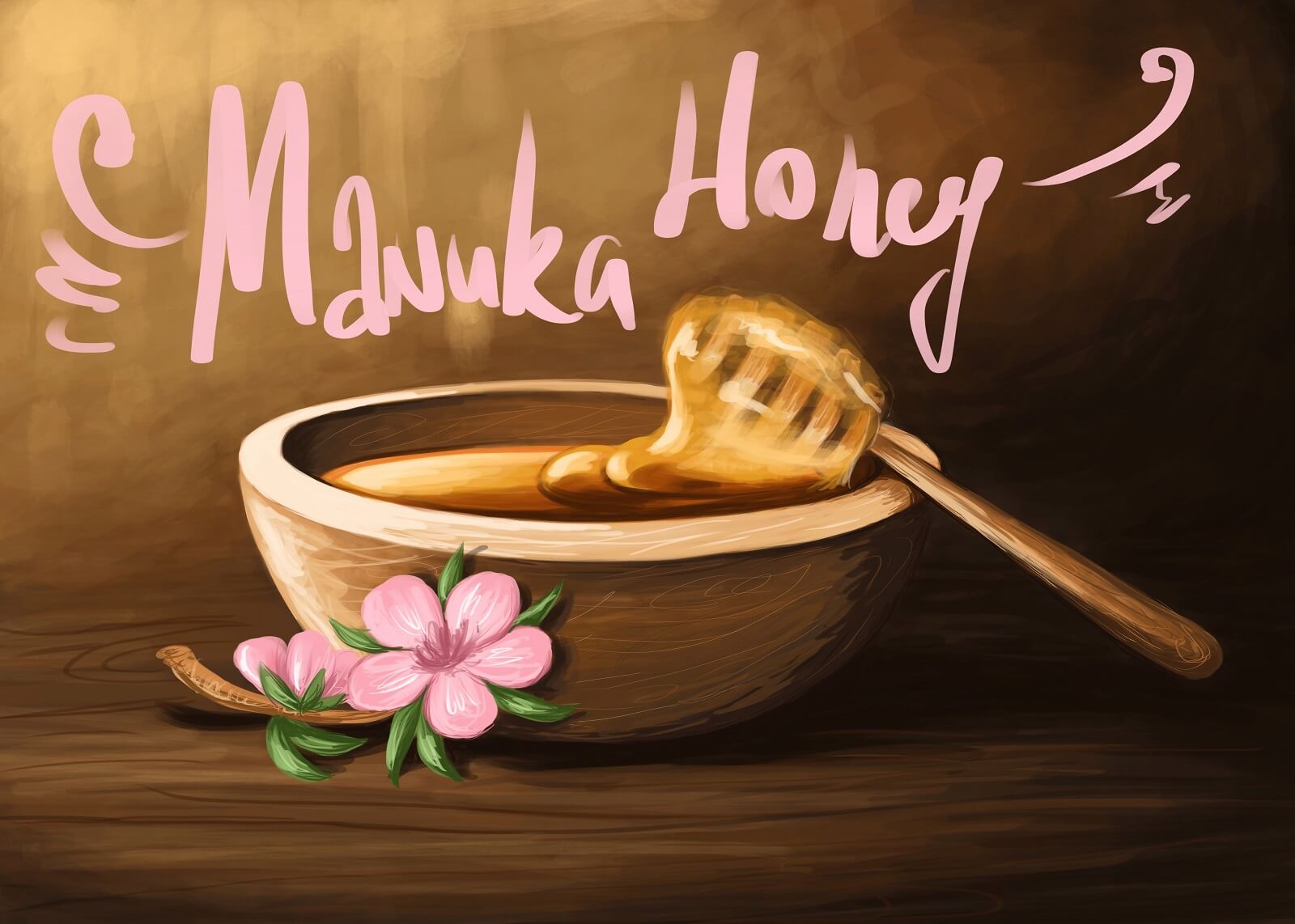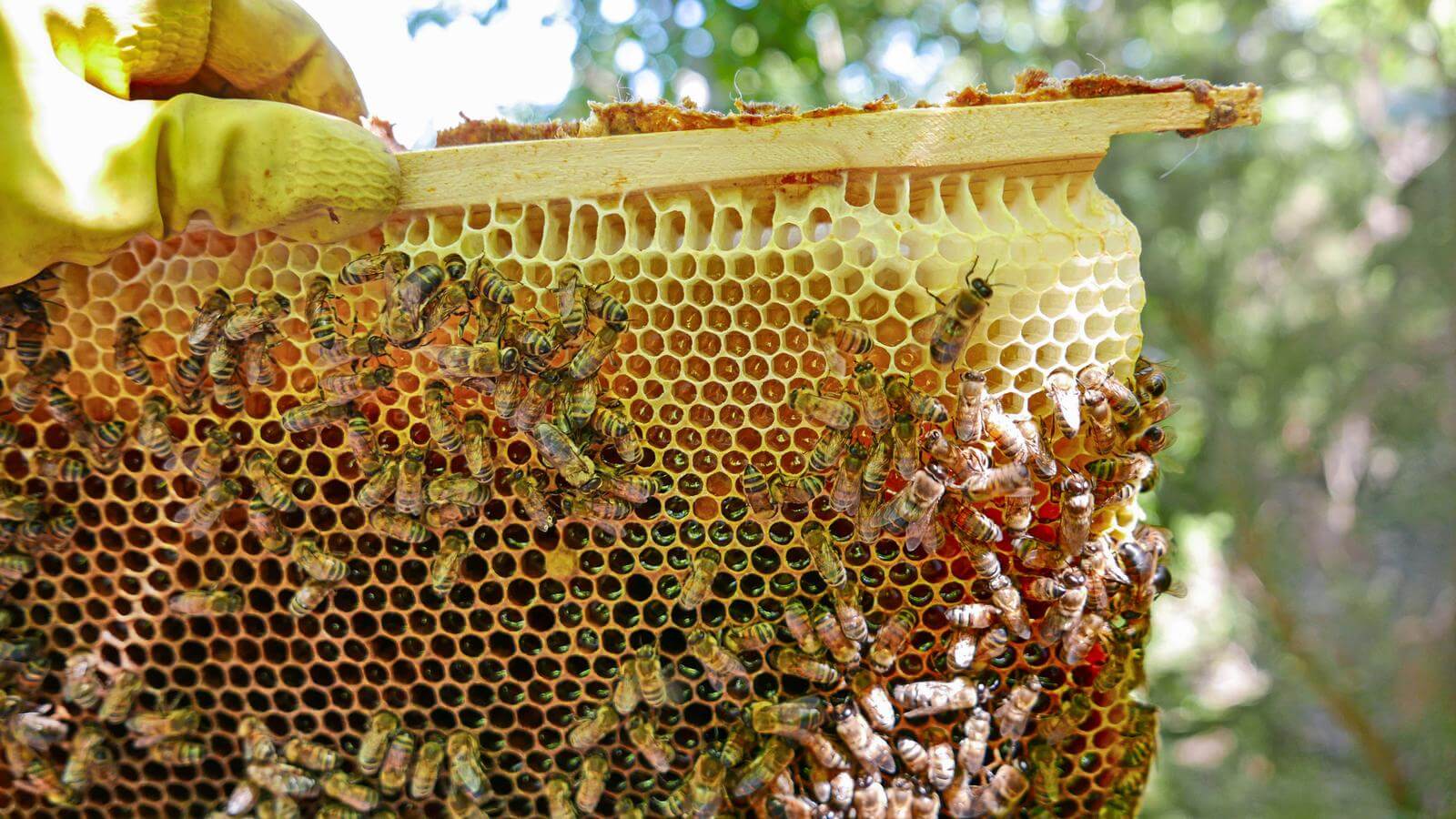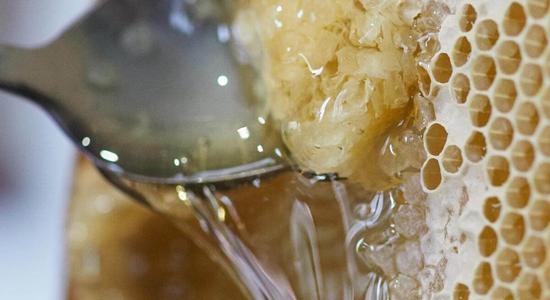See all "Honey" Section Topics

It is true that honey will inhibit the growth of Candida albicans, the yeast that causes approximately 80% of all Candida infections. But what about certified Manuka honey? Will manuka honey really do a better job at getting rid of yeast infections than other types of honey? This will be discussed this and you can know what research has to say about the efficacy of manuka honey as a Candida infection treatment. Also, you will find out a way to make any honey even better at curing a yeast infection.
What is Manuka Honey
Manuka honey is a honey that is primarily made in New Zealand and comes from bees that gather the nectar of the Manuka plant (Leptospermum scoparium). The nectar of the manuka plant is rich in dihydroxyacetone, a compound that creates methylglyoxal (MG) in honey. Many types of honey contain MG; however manuka honey can contain more of this chemical. Honey producers have developed a rating to show how much plant chemicals (derived from the Manuka plant nectar) are present in honey. This rating is called UMF; standing for “unique Manuka factor.”
A honey with a UMF rating of 10 or more is known as “active manuka honey.” This honey is certainly not as commonplace as artificial honey or regular honey. The cost of this honey is staggering; and, one has to wonder how it could be worth the money. Although this honey does contain more manuka phytochemicals, the question is, if it really is worth paying so much for this type of honey. If it cures a yeast infection much better, it might be worth the high cost; yet, if it doesn’t really do much better than ordinary honey, it is just a waste of your time and money.
A 1/2 Day & Yeast is Gone!
Linda Allen suffered from yeast infections for years. Through researching natural medicine & Candida, she found an efficacious solution!
Linda is one expert you want on your side! Let her show you how to get rid of a superficial yeast infection in just 12 hours; AND, keep it gone!
A 60-day, 100% money back guarantee is provided.
Visit Official Site!Manuka Honey versus Other Honey

One study demonstrates the true value of manuka honey very well. The study was published in the Journal of Coastal Life Medicine (2015; 3(7): 539-542). The study used artificial honey; which is primarily various types of sugar and lacks plant chemicals regular honey would contain. Additionally, the study also used regular honeys as well as manuka honey. The regular honeys were provided by the Department of Agriculture Malaysia. These honeys are as follows:
- Manuka honey with unique manuka factor 10+ (Kordel’s®, New Zealand)
- Honey from Melaleuca spp. (Gelam) trees
- Honey from Ananas comosus (Nenas) trees
- Honey from Koompassia excelsa (Tualang) trees
- Honey from Acacia auriculiformis (Acacia) trees
The researchers in this study made their own artificial honey. An excerpt below, taken from the published study, details how they made this honey:
The artificial honey was prepared by dissolving 3 g sucrose, 15 g maltose, 80.1 g fructose and 67 g glucose in 34 mL sterile deionized water. The solution was heated briefly to 56 °C in water bath to aid dissolving. Research Gate PDF
Surprisingly, the study found that artificial honey, Gelam honey, and Tualang honey all inhibited Candida albicans about the same. Yes, manuka honey did inhibit Candida albicans a touch better than all the honeys; however, this difference was quite negligible.
As a result of this study, it is clear that Manuka honey is not really worth it when it comes to stopping Candida albicans. You are likely to be able to get the same effect from a cheap jar of artificial honey that costs but a fraction of the price manuka honey does.
If you do want the affects of manuka honey, you probably don’t need to rely on the bees to get the active ingredients in manuka that are Candicidal. You can always just use some manuka essential oil and add a few drops to whatever kind of honey you have on hand. Instant, probably much more powerful, manuka honey! Essentially, expensive manuka honey’s only differentiation; given the fact you can add manuka essential oil to a honey; is that bees put the manuka phytochemicals in it instead of a person with a bottle of essential oil.
So does the essential oil of the Manuka plant actually possess antifungal capabilities? The answer is “yes!” There was one study that analyzed the effects of Manuka plant essential oil on Candida albicans to see if it could inhibit this fungus. The study was published in The International Journal of Aromatherapy [(2006) 16, 169–174].
This study analyzed several different essential oils; one of these oils was derived from the manuka plant. The study reported that manuka oil was able to inhibit and kill C. albicans and C. glabrata. Although, it should be noted that other essential oils worked much better than manuka essential oil. Lemongrass essential oil was many times more effective at killing Candida than manuka oil.
Given this finding, you should probably just use whatever honey you have on hand and add in some essential oils that are the best at treating Candida. Read more about essential oils and Candida here.
Eliminate Bacterial Vaginosis & Vaginal Odor
Jennifer O’Brien is one prominent expert on BV that knows how to get rid of vaginal odor. BV is a common infection that you don’t have to put up with.
Jennifer will show you how to naturally eliminate vaginal odor in just 3 days.
A 60-day, 100% money back guarantee is provided.
Visit Official Site!Raw Organic Manuka Honey

Using raw organic Manuka honey probably will not be any different than using a good multi-floral honey for Candida infection. As you read, even artificial honey can inhibit the development of Candida yeast. Organic manuka honey is likely to be even more expensive and provide negligible, if any, difference in Candicidal ability. It would perhaps be wiser to spend your money on some good herbs and essential oils that kill Candida and mix them into your honey. This strategy should be a great, all-natural yeast infection treatment; and, could cost less than exotic manuka honey.
Clair Goodall: Author & Nature Lover
Clair Goodall is a bee-obsessed natural medicine convert from Minnesota. She is one expert you might want to know more about!
Clair will help you protect you and your family from toxic products and chemicals and help you discover solutions from nature.
Also, Clair’s book is backed by a 60-day, 100% money back guarantee
Visit Official Site!Manuka Honey in the Vagina
Manuka honey is not much different than regular honey. There are no special considerations for using Manuka honey vaginally. What might be something to do is to crush up some fresh garlic cloves and add the mixture to the honey you put in your vagina. Garlic is a great antifungal and can stop Candida in its tracks. Garlic and honey have been used since ancient times to treat infections of all kinds.
Manuka Honey Health Benefits

Manuka honey does not produce hydrogen peroxide when it comes into contact with body fluid; it is known as a non-peroxide honey. As mentioned on the page about regular honey for yeast infections, hydrogen peroxide actually can stimulate the growth of Candida albicans.
Aside from being a good yeast infection treatment, honey is also a great remedy for bacterial problems. One study tested the antibacterial effects of several different types of honey; one of which was manuka honey. The study focused on bacteria that typically infect wounds. The study was published in the Journal of Applied Bacteriology [Volume 73, Issue 5, pages 388–394, November 1992].
The researchers reported that Manuka honey did not seem to have a significant difference on how it affected the bacteria compared to the hydrogen peroxide producing honeys. The study stated that all the various species of bacteria were inhibited successfully by concentrations of honey below 11%. And if you are using 100% pure honey, you are sure to drastically stop the bacteria on a wound. Consequently, it is really not worth procuring costly Manuka honey when you want to treat infections.
Manuka Honey Side Effects
As we all know, honey is made from flower nectar. Some of the pollen from the flowers may get into the honey. So, if you have problems like being allergic to pollen, you might also have an allergic reaction to honey. Before you use it vaginally, try putting a dab of manuka honey on your skin and see if any adverse reactions occur.
Overall, you should be very safe using manuka honey for a vaginal yeast infection. It’s literally a food you can eat.
Linda Allen’s 12 Hour Candida Cure

According to Dr. Sobel, in his delineation of recurrent vaginal yeast infections, published in Current Infectious Disease Reports [4.6 (2002): 514-519]; recurrent Candidiasis is by no means easy to deal with, and is not uncommon. Recurrent vaginal Candidiasis is defined as four or more yeast infections in the course of a year’s time. Dr. Sobel states that this problem can be a major therapeutic challenge for health practitioners. According to the study, the exact rate of recurrent yeast infections is unknown, but is speculated to affect around 5% of women in their reproductive years; this rate could possibly be higher. One woman who was the victim of repeated yeast infections, like many other women, was Linda Allen.
Linda’s story starts out perhaps much like that of other women who suffer with systemic Candida. Linda’s yeast infection problem started in her teen years; around the same time she developed a sinus infection. Linda quickly made an appointment with her physician to get a prescription for her vaginal malady. In a short time, the drugs she got from her doctor did the trick—initially. After a little time passed, Linda found her vaginal yeast infection had come right back! Linda again made a visit to her doctor and got another prescription. The antifungal drugs worked again, initially; however, like before, it wasn’t long before her yeast infection was attacking her body again.
As time went on Linda’s health continued to worsen; she had the common general bad health systemic Candida can create. Linda’s doctor kept prescribing her stronger and stronger antibiotics for her bad health. Those who knew Linda may have thought she was a hypochondriac—due to her routine visits to the doctor—or just thought she was in worse shape physically than she was letting on.
Linda’s poor health and frequent vaginal Candida outbreaks kept ruining her life; and she was mystified by her miserable physical condition. The first breakthrough came when she consulted a naturopath about her issues. The naturopath quickly informed Linda that she had a severe systemic Candida problem; this was the source of all her pain. The naturopath was not able, however, to permanently end Linda’s yeast infections. But, this was a turning point; the next few years would change Linda’s life.
Linda would spend the next 12 years acquiring information on Candida. She read numerous health books and other medical research. When a doctor or natural medicine expert was kind enough to lend her some time, Linda would diligently inquire about Candida related information. Linda also tried a plethora of alternative treatments for yeast infections. She found that staying on a Candida diet would only work while you adhered to strict dietary protocol; and after you cheated, yeast infections would come right back. Through all this, Linda began to understand the need to address the underlying causes that led men and women to get yeast infections. And, she began to develop a method to deal with these “root issues” and end her yeast infections permanently.
With all her experience and study, Linda finally started to put together a treatment regimen to permanently cure her of Candida. Linda spent about a year refining and polishing her new approach until the time came for her to put it to the test. Linda was delighted to see that after a short while on her program, her vaginal yeast infections cleared up. As time went on, Linda found her health was rapidly improving; and, her yeast infections were staying gone. Linda had finally done it; she had found a new approach to solving the Candida dilemma. With her good health restored and her yeast infections gone; Linda was a changed woman.
Linda has since written a comprehensive book detailing exactly how to repeat her success. Her book includes a fast working program that will clear up a vaginal or penile yeast infection in just 12 hours time—naturally. And, by following her unique step-by-step system, you can remove the systemic Candida from your body in a few weeks. Linda’s program is guaranteed to end even the most stubborn, recurrent yeast infection problem. Since Linda’s book was first published in 2004, over 100,000 people from around the world have used this novel therapy to end their yeast infections and keep them gone.
Linda has published her book with a large, credible online publisher; owned by the large U.S. based firm Keynetics Incorporated. Linda, also knows what it is like to be disappointed by a supposed Candida cure, and so offers a 60 day, 100% money back guarantee on her book. Linda’s book can be downloaded instantly online; and, if you feel unsatisfied with her therapy, you can get your money back without having to return anything.
For more information on Linda’s book, learn about her personal story with systemic Candida, to see some of the bonus books she offers for free with her book, or to see a myriad of testimonies of people who have used her book, you can find out much more at Linda Allen’s website.
Author: Mr. Nicholas Gross

Nick Gross is a natural medicine enthusiast who has been researching and writing about natural medicine since 2008. Nick is primarily a web developer but also researches and authors written and video content about natural health. Nick has a bachelor’s degree in Management Information Systems from the University of Northern Iowa.
Disclaimer
The information on this website is not a prescription for anyone. This information is for informational or educational purposes only, and is not a substitute for professional medical advice or consultations with healthcare professionals.
Affiliate Disclosure
Some of the links provided on this website are affiliate links. When a purchase is made through these links, Candida Hub earns money from commission. This helps to keep the website up and helpful to people for free. Thank you for any support!
Stay Up to Date
If you enjoyed this article, consider following / liking our Facebook page. This page is primarily utilized to alert followers of new articles that are put on Candida Hub. Candida related news is also discussed. While you are there, you can see what has been more recently added to Candida Hub.
SOURCES:
- Research Gate PDF — Antifungal activity of selected Malaysian honeys: a comparison with Manuka honey. Journal of Coastal Life Medicine (2015; 3(7): 539-542)
- http://dx.doi.org/10.1016/j.ijat.2006.09.005 — In vitro activity of essential oils on microorganisms isolated from vaginal infections. The International Journal of Aromatherapy [(2006) 16, 169–174]
- http://dx.doi.org/10.1111/j.1365-2672.1992.tb04993.x — A comparison of the sensitivity of wound-infecting species of bacteria to the antibacterial activity of manuka honey and other honey. Journal of Applied Bacteriology (Volume 73, Issue 5, pages 388–394, November 1992)
- http://dx.doi.org/10.1007/s11908-002-0038-7 — Sobel, Jack D. "Pathogenesis of recurrent vulvovaginal candidiasis." Current infectious disease reports 4.6 (2002): 514-519. PubMed







